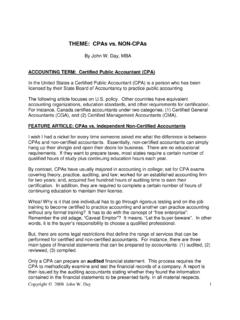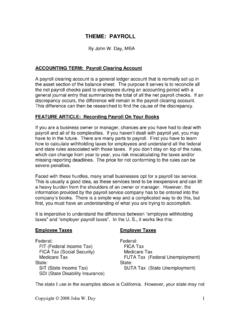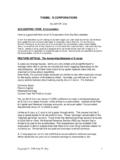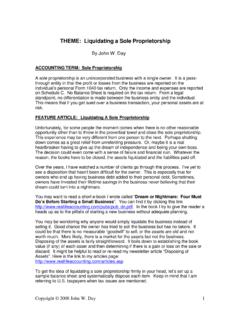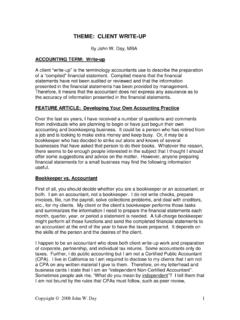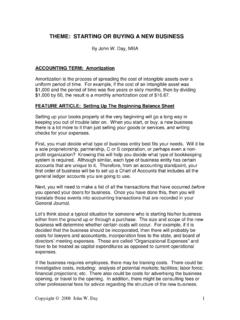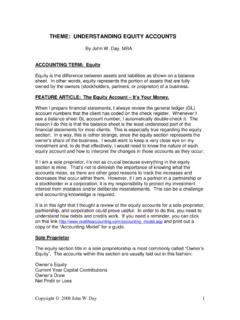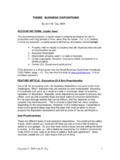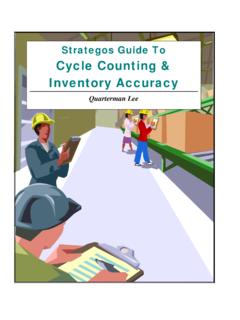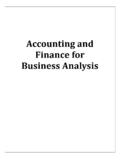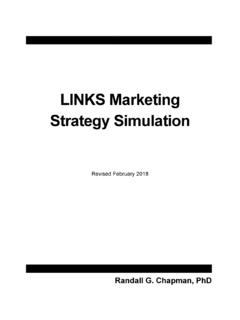Transcription of RLA Article Accounting for Inventory
1 Copyright 2008 John W. Day 1 THEME: Accounting FOR Inventory By John W. Day, MBA Accounting TERM: Inventory Inventory can be defined as goods being held for resale. In manufacturing, Inventory can be raw materials, work-in-process, and finished goods. FEATURE Article : Understanding Inventory Accounting Occasionally I do live seminars on the basics of Accounting and have found that many participants had difficulty in understanding how Accounting for Inventory works. Let s be clear, working with Inventory can be complex depending on the type and size of business. However, the basic concepts of Inventory are not hard to grasp and you really should have some familiarity with them.
2 For those who already work with and understand Inventory , please bear with me as I lay out the fundamentals. Also, this newsletter is a little longer and more technical than usual, so you may want to take your time reading it. You may recall from my August newsletter, issue #64, titled Cost of Goods Sold, the Inventory formula: Beginning Inventory $ Add purchases during the month + Subtract ending Inventory - Cost of Goods Sold $ The first step is to conceptualize the Inventory process . In other words, think about what is going on. For example, suppose your company is in business to sell a product.
3 The product is acquired either by manufacturing it or purchasing it as a finished product. During an Accounting period, such as one month, all, or a portion of the Inventory is sold. Hopefully, the cost of the product did not exceed its sale price so that a profit was realized. With the money from the profit, more Inventory can be purchased to sell, cover overhead expenses, and pay yourself. The challenge is to determine, as accurately as possible, your Cost of Goods Sold (COGS). There are various ways to do this depending on whether a periodic or perpetual system of recording Inventory is used. In case you are unfamiliar with these terms, let s review them: Copyright 2008 John W.
4 Day 2 Periodic Periodic Inventory Accounting involves an increase (debit) to Purchases when acquisitions are made. Remember, Purchases is a general ledger (GL) account found in the cost of sales section of the Profit & Loss Statement. At the close of the period, a physical count of the remaining Inventory is required to determine the amount unsold. The quantity is then priced and recorded in order to determine the COGS. (See formula above and/or The Journal Entry August issue #64) Here is a quick example, using T-Accounts: (a)Beginning Inventory was $3,000 (b)Purchased new Inventory of $1,000 (c)Counted remaining Inventory of $2,500 (d)Adjusted Purchases and Inventory to reflect actual ending Inventory Cash Inventory Purchases | 1,000 (b) (a) 3,000 | 500 (d) (b) 1,000 | 2,500 (d) 500 1,500 Perpetual As acquisitions of new Inventory are made, they are charged (debited) to the Inventory account.
5 Each time a sale is made a corresponding entry is made removing (crediting) the item from Inventory and charging (debiting) COGS (or Purchases). The result is that the Inventory account maintains a current balance, and the COGS account reflects the cost of goods sold to date. One of the benefits of using a perpetual Inventory system is that you can run interim financial statements without the necessity of a physical Inventory count. In addition, shortages and any other discrepancies may be discovered and corrective action taken. One way to remember the difference between the two methods is that the periodic system discloses what is on hand, whereas, the perpetual system discloses what should be on hand.
6 Once the Inventory system you are going to use has been selected, the method by which to price the Inventory has to be selected. You may have heard of some of these methods, , FIFO (First-in, First-out); LIFO (Last-in, First-out); Weighted Average; Specific Identification; and Retail Method. Here is a brief overview of each: Copyright 2008 John W. Day 3 Conventional Inventory Pricing Methods FIFO First-in, first-out (Last-in, Still-here) implies that the items that were purchased first will be sold first. Cost of goods sold is calculated by using the oldest prices, and ending Inventory is calculated based on the most recent prices.
7 Using this method tends to result in a fair statement of Inventory on the Balance Sheet. This is because the ending Inventory was purchased most recently. Further, when Inventory turns over regularly, the prices used for the cost of goods sold are somewhat current resulting in fair presentation of the cost of sales amount. LIFO Last-in, first-out (First-in, Still-here) implies that the items most recently acquired will be the first sold. Cost of goods sold is calculated by using recent prices, while ending Inventory is calculated using the oldest prices. This method tends to emphasize the matching concept Accounting principle by matching current costs with current sales on the Profit and Loss Statement.
8 Eventually however, the Inventory prices used for balance sheet purposes may become outdated and unrealistic. This is because current prices may rise or fall causing the true value of the ending Inventory to become under or overstated. Weighted Average This method involves assigning the same unit price to items in Inventory and to items in COGS. The price assigned is the average price for the period calculated by taking the total cost of beginning Inventory plus the cost of all units purchased during the period and dividing the total by the number of units involved. For instance: Using Periodic: 100 units purchased @ $ on Jan 1 = $100 150 units purchased @ $ on Jan 14 = $300 130 units purchased @ $ on Jan 26 = $325 380 Cost per unit ($725/380) = $ $725 Cost of Goods Sold 140 (380 240) @ $ $267 Ending Inventory 240 @ $ $458 Total Units Reconciled $725 Copyright 2008 John W.
9 Day 4 Using Perpetual: January 1 - Balance 100 units @ $ $100 14 - Purchased 150 units @ $ $300 Balance 250 units @ $ ($400/250) $400 19 - Sold 140 units @ $ Cost of Goods Sold $224 Balance 110 units @ $ $176 26 - Purchased 130 units @ $ $325 Balance 240 units @ $ ($501/240) Ending Inventory $501 Summary: Cost of Goods Sold $224 Ending Inventory $501 Total Units Reconciled $725 Notice that, in this particular case, the COGS using the periodic system is higher ($267) than the perpetual system ($224). Translating the outcome further, you can see that Gross Profit will be higher using the perpetual system because COGS is lower.
10 For example: Periodic System Perpetual System Sales $1000 $1000 Cost of Goods Sold -267 -224 Gross Profit $ 733 $ 776 Suffice it to say that using a FIFO method, the outcome is the same when using either the periodic or perpetual system. LIFO is a different story because the outcome varies when using either the periodic or perpetual system. FIFO and LIFO will produce different results in calculating the value of the closing Inventory . In times of inflation when prices are rising, LIFO will produce a larger COGS and a lower closing Inventory . In time of falling prices, FIFO will produce the larger COGS.
